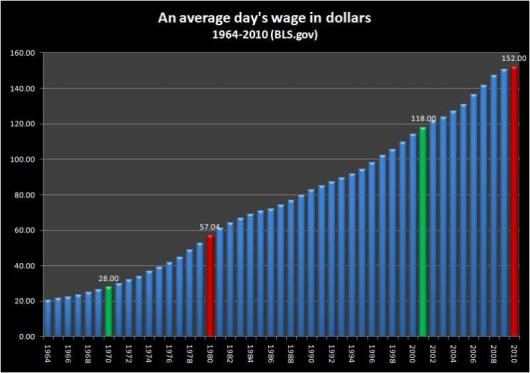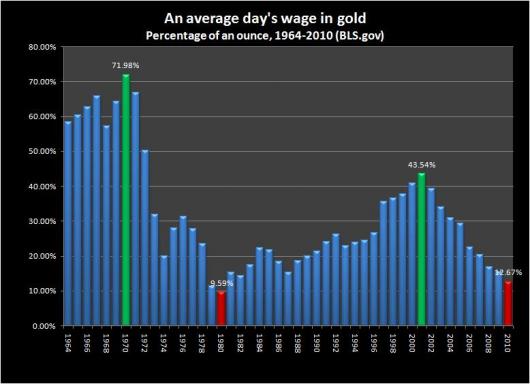One of the most visible measures of the condition of working families is the price level of a day’s wages. So, we figured it might make sense to subject those wages to the same sort of analysis we used in the last post: the withering criticism of an ounce of gold.
Here is a chart of an average day’s wage since 1964, as presented by the Bureau of Labor Statistics:

Chart 1: Average day's wage in dollars (1964-2010) (Source: bls.gov)
As is befitting a labor force enjoying the prosperity of the freest, most productive, nation on the planet, we have seen our wages rising for the entire period from 1964 to 2010. Even through depressions as intense as that of the Great Stagflation (the first set of green and red bars) and the current Great Recession (the second set of green and red bars) the average day’s wage of American workers has never fallen year over year.
Unfortunately, things are not so rosy when the value of a day’s wage is measured by an ounce of gold:

Chart 2: Average day's wage in gold (1964-2010) (Source: bls.gov)
As measured by gold, the value of a day’s wage reached its zenith in 1970, when those wages measured in dollars were a lowly $28! Although a day’s wage more than doubled to $57 by 1980, their value, measured by gold, fell by 87 percent to just 13 percent of 1970′s magnitude.
From this low point in 1980, wages again double to $118, while the value of those wages jump 4.5 times their 1980 lows. However, this gain only brings them to about 61 percent of the value they had in 1970. This gain also marks the top of the business cycle as the value of a day’s wage again turns lower in our current depression – falling to the present level.
In 1970, a day’s wages could buy nearly three quarters of an ounce of gold; by 2010 those wages could only buy a little more than one eighth of an ounce of the metal. Your wages have quintupled since 1970, yet you actually have become poorer. If you are making the average hourly wage of $19 per hour, you are experiencing a level of poverty that was unimaginable to your grandfather, who made only $3.50 an hour in 1970.
*****
The value of a day’s wage and the value of an ounce of gold – how much of one can be exchanged for the other, their exchange ratio – is, of course, subject to fluctuations arising from supply and demand, the business cycle, and improvement in the productivity of work.
If there is a shortage of labor power, we can expect it to trade above its value; if there is a surfeit of labor power it will trade below its value. During periods of economic expansion, we would expect it to trade at the upper end of these fluctuations; and contractions would lead it to trade toward the lower end of those fluctuations. Improvement in the productivity of gold producers might either outstrip or lag that of a typical basket of goods which compose a working class household budget.
All of these influences mean that labor power will only trade with gold at an exchange ratio reflecting their relative values over some period of time, and through a lot of market noise. It would be almost impossible to say with any accuracy whether any given wage was actually THE value of wages in the form of the gold commodity.
Now, let’s add another wrinkle: the currency in which those wages are denominated is itself worthless, and, therefore, completely incapable of reflecting the value of anything – either gold or labor power. Since the dollar in which wages are denominated is itself subject to fluctuations in its floating exchange ratio with gold, we are dealing with three independently moving variables – each of whom are subject to the peculiarities of their own processes: a basket of commodities composing the value of labor power, gold, and the debt manufacturing (i.e., money creation) process. And, all of this is unfolding in the context of a vast global economy.
There is, in short, an area of indeterminacy to this process through which your Nana could drive a Mack truck, pulling her RV, SUV, and tricked out Harley, while Grampy is snoring, mouth wide open, in the passenger seat.

Comments
interesting analysis
But be it said, by any measure the middle class has been under attack for 30 years.
middle class under attack
True...if you look at gold prices, it looks like the process actually began about 1970, and built in strength through the 80s and 90s...
I am trying to build a case for using gold as an analytical tool in place of dollars. It seems to retain its analytical value despite the fact that it is not money. My next step is to show how housing prices over the same period performed in comparison to wages...
PPP
purchase power parity, or PPP is the more common method to show the differences and the "wage squeeze" of Americans. I don't know if you can in turn scale that to gold prices.
But regardless, every single day we have another outrage which is just decimating the U.S. middle class and it does seem to start with the Nixon administration and continue on from there, doesn't matter what party is in power.
Gold
Fortunately, we don't eat gold. Else, an ounce of gold would have been equal to pounds of flesh!
Shekhar Sathe